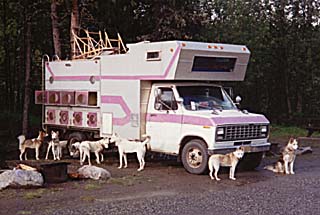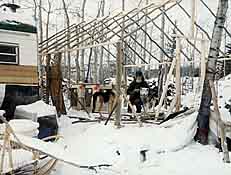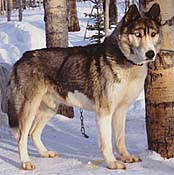HAVING MADE THE DECISION TO RETURN TO NORTH AMERICA, we had to find a place to settle with the dogs. We knew we didn't wish to return to Saskatchewan, southern Ontario, Québec or any other place we had previously lived. Weather in the East had become rather dodgy; the sensible thing would be to go someplace where snow would be guaranteed. Immediate possibilities were the Yukon and Alaska. My reconnaissance trip in March 1993 revealed that the Yukon would not be a bad choice, provided we could find property: little titled land was available. I bought an old pickup and drove to Fairbanks, where there was plenty of real estate on the market. Intending to investigate the area for two weeks, I returned after four days! Alaska was not for us -- it seemed a fragmented, disturbed society with a myriad of special-interest groups all at one another's throats. Canada was still a gentler, less violent place than the USA and that appeared to hold true even in the far North. Back in Whitehorse, unable to find affordable property with a house or a cabin, I bought a 6.8 Ha. (17 acre) parcel of unimproved, unserviced land twenty miles north of the city. It was primitive but beautiful. Lying beside the Klondike Highway that went to Dawson City, our parcel lay between Lake Laberge and the Miners' Range mountains. The land secured, I returned to Isa in Spain, via Wisconsin. There I purchased Carolyn's dog truck, boarded my new Ritter dogs with Deb Serbousek, and put ADOLPH, YOGI, CABBAGE and FLAPPER on the airplane with me to go to their new owners in Spain.

WHEN I RETURNED to the kennel wearing a baseball cap, poor SEPALLOP barked furiously at me until I removed the cap and suddenly he recognised his Boss -- then he was mortified! I delivered Carolyn's four Seppalas to their new owners. In about three weeks I was ready to return to the Yukon. Isa assured me she could handle the packing of our belongings for shipping later on. Isa had succeeded in selling her entire kennel of racing Siberians to one buyer at an amazing price that financed air cargo shipping of all the Seppalas. Two dozen Seppalas were crated and put on two separate flights from Barcelona airport. They and I flew into Milwaukee, where I had left the truck. They all weathered the transatlantic flight well (with their stakeout chains hidden in the bottom of their crates!) and we left the airport in a pouring rainstorm.
I picked up XPACE, GRIZZLY, DALLY, SPRITE and ZIRCONIA at Deb's place in Iron River, WI, installed four more compartments in the dog truck, bought some more Windigo harnesses and hit the road for the Yukon. The trip was steady and relatively uneventful, though I got careless and left the cab door open in the Kiwanis park in Vegreville, AB, right beside the highway. DREAMA and KIDRON bounded out, glad to stretch their legs. DREAMA ran twice around the truck and came right to me; but KIDRON decided to run the length of the park. Terrified of her getting on the highway, I ran after her screaming her name, to the amusement of onlookers. She ran all the way down the park, stopped, considered, and ran all the way back to the truck -- KIDRON had re-enlisted for the duration!

WE ARRIVED IN THE YUKON on the 9th of July, 1993. The descendants
of Leonhard Seppala's little sleddogs were back in Gold Rush
Country after a sixty-year absence. There was
only raw land there; the dogs had to live in and out of the
dog truck while I established a dogyard, pounding two-inch
steel pipes into rocky earth, clearing away deadfall trees,
pouring pilings for a kennel building, clearing a "house
site" (for a house that never got built), and buying
materials for doghouses. Everything went too slowly as the
evanescent Yukon summer slipped away. In September as the
aspen leaves briefly blazed golden, I drove down to Skagway
to meet Isa with our two Bernese Mountain Dogs on the Alaska
Marine Highway ferry. Our belongings had been packed and
shipped by sea, but the Masía Maurí property
still had not been sold.
We needed shelter for the
winter. A friendly neighbour loaned us a holiday trailer; I
bought a second-hand 14 by 16-foot wall tent. We had arrived
with 26 sleddogs plus the "Rat Pack" of rescued Spanish
GSD-mongrel Lost and the two Berners Enzo and Gaby; they,
too, needed shelter. I was building doghouses, but too
slowly, so we bought a roomy 16-compartment dog box that had
seen better days and placed it blocked up beside the
dogyard.

(Breeder Curt Stuckey,
by NUTOK OF MARKOVO
ex MOKKA OF MARKOVO
WE HAD UNFINISHED breeding business right away. GRIZZLY OF
SEPP-ALTA had not been bred at Carolyn's and was getting
old. We didn't want puppies immediately, but felt we had no
choice. Grizz was mated to DALLY OF SEPPA-ALTA at her fall
heat. Unfortunately the breeding didn't take; in mid-March
of 1994 the magnificent old dog died of lymphoblast sarcoma,
aged eleven. That was a terrible blow to our breeding programme;
Grizz had been so like DITKO OF SEPPALA and it hurt to see history
thus repeat itself.
The snow was already flying as
October drew to a close and the wall tent was erected.
DREAMA, KIDRON and NORDE lived in the tent with me; twelve
of the kennel dogs spent most of the winter in the
second-hand dog box at night, having stakeouts but no
houses.
Both we and the dogs found the
Yukon a spooky place at first, with its vast expanses of
wilderness. The dogs were nervous, as were their two
drivers. We thought we were having troubles with our teams,
until one day in early winter when I took a ride in the
basket of a locally famous long-distance driver's team! It
was early season, and his dogs were tangling frequently,
leaders were trying to come haw and return home -- his team
seemed chaotic! I went back home and hugged my team dogs,
telling them I hadn't realised what good kids they really
were! Perhaps the unfamiliar atmosphere of the Yukon made
them a little bit jumpy, but their behaviour
in harness was impeccable, markedly unlike that of the Yukon
Quest dogs I had just ridden behind.
